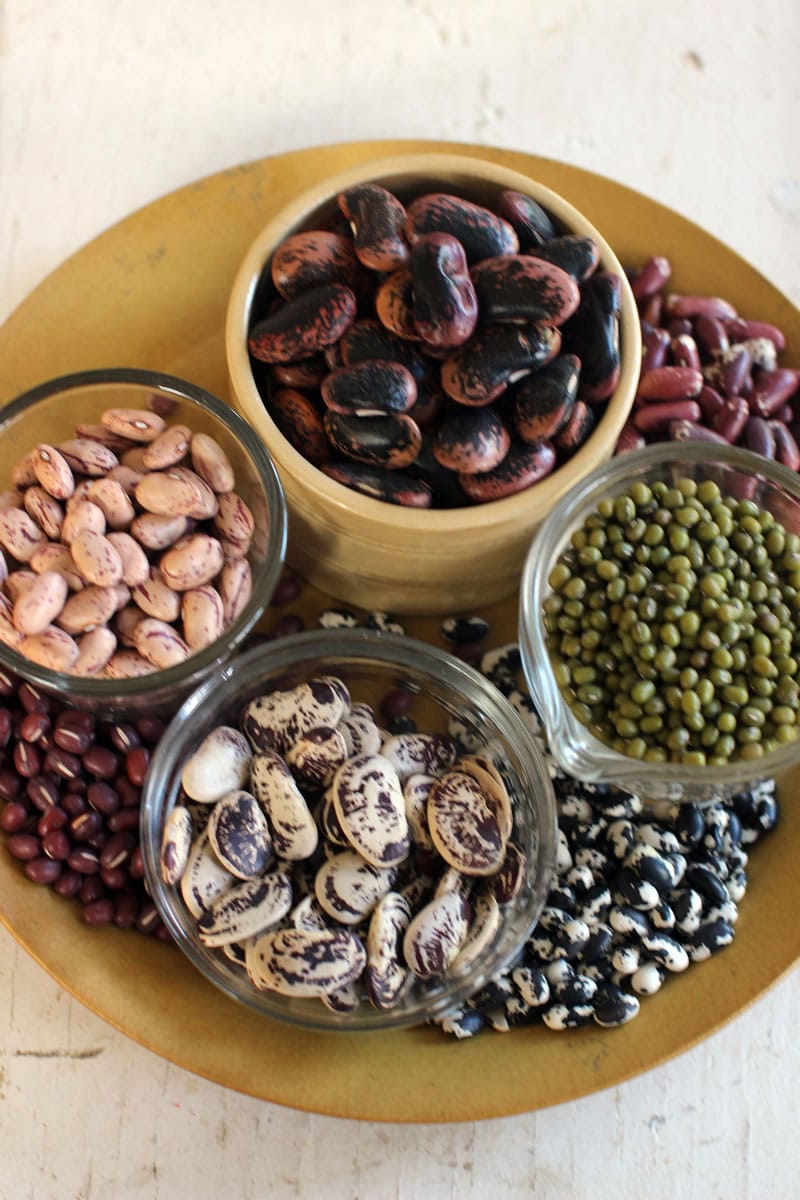Until I went off to college and became a vegetarian out of financial necessity, beans really weren’t a part of my life.
But once I found myself pinching pennies while sharing a house with three other women, beans became a great and affordable source of bulk and protein. And though the initial motivation was saving money, we eventually grew to love the unique flavors and textures of beans, and I have continued to cook with them ever since.
And the best way to make beans? Starting with dried beans. Why take the time to cook dried beans when you can find a wide variety of canned available? There are several reasons.
Dried beans cooked from scratch have a more uniform texture than most canned beans (some of which tend to get mushed in the can). Also, you can control what gets added to the beans (particularly salt). And they cost much less than canned beans. A 16-ounce bag of dried beans yields roughly 5 or 6 cups of cooked beans, while a 15-ounce can of cooked beans yields roughly 1 1/2 cups. Finally, homemade beans freeze beautifully, so why not make a big batch on the weekend and use it in recipes later in the week?
But there are a few things to keep in mind regarding dried beans.
Dried beans seem to last forever on the shelf, but beware: The older the bean, the longer it will take to cook. So try to buy your beans from a store that has plenty of turnover.
There has been a long debate about whether to soak beans before cooking them. The main reason for the pre-soak is to speed up the cooking time. And a pre-soak does indeed do that, by about 30 minutes. But Cook’s Illustrated magazine has uncovered an even better reason. If you soak beans in salted water overnight, they not only absorb some of the salt (which seasons them), they also come out more tender. For years we were all told that salt made beans tough, but it’s quite the contrary. So I recommend a pre-soak in salted water.
Acid of any kind, however — tomatoes, citrus, vinegar, wine, etc. — is the enemy. It will prevent the beans from cooking properly. If you want to add a touch of acid to your beans, add it only when the cooking is nearly done.
The basics for cooking almost all dried beans (except dried lentils and split peas, which cook so quickly you can make them from start to finish in about 20 minutes) are below. I won’t offer exact cooking times because the timing can vary widely depending on the variety and size of the beans, as well as how fresh they are. I have offered cooking methods using both stovetop and a slow cooker. Whichever you choose, save the cooking liquid. It is delicious added to soups and stews.
Master Recipe For Cooking Dried Beans
Start to finish: 13 to 15 hours (15 minutes active). Servings: 10
1 pound dried beans
3 tablespoons plus 2 teaspoons kosher salt, divided
1 medium yellow onion, quartered
1 medium carrot, cut crosswise into 4 pieces
1 celery stalk, cut crosswise into 4 pieces
2 cloves garlic, crushed
2 sprigs fresh thyme
Sort through the beans to pick out any random stones or sticks among them, then rinse and drain the beans.
In a large bowl or pot, dissolve 3 tablespoons of the salt in 4 quarts of water. Add the beans, stir, then cover and soak overnight at room temperature.
The next day, drain the beans and rinse them. In a large saucepan or stockpot, combine the beans with 7 cups of cold water. Stir in the remaining 2 teaspoons salt. Bring the mixture to a boil, skimming the scum that rises to the surface with a skimmer or slotted spoon (that scum is protein solids). Reduce the heat to a simmer and simmer the beans, regularly skimming the scum, until no more scum rises to the surface.
Add the onion, carrot, celery, garlic and thyme, then simmer for 30 to 60 minutes, or until the beans are just tender. Drain the beans, reserving the cooking liquid (if desired) and discard the onion, carrot, celery and thyme stalks. Use the beans in recipes or freeze them in 1- or 2-cup portions.
Slow Cooker Method
Soak the beans as described above, then drain and rinse them. In a slow cooker, combine the beans with the 2 teaspoons of salt, onion, carrot, celery, garlic and thyme. Add enough water to cover the beans by 1 inch, then cover and cook on high for 4 to 6 hours, or until completely tender.



